
MERCEDES BENZ E-Klasse and predecessors
Generations Timeline, Specs and Pictures
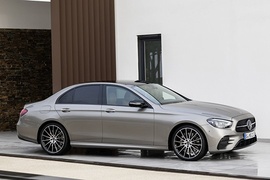
The three-pointed-star German brand introduced a facelifted version of its respected executive sedan E-Class in 2020, as a measure for the Euro 6d norms, which started in January 2021.
Ever since 1953, before even the E-Class had that name, the luxurious Mercedes-Benz range was well received by the market. Each time a new generation was introduced, it was a benchmark for its class. The first generation to receive the E-Class badge was the facelifted, 1993, W124 model. The 2020 model was the facelifted version for the fifth generation, which stormed the showrooms in 2017.
Mercedes-Benz introduced the facelift in 2020 with a new set of LED headlights and flatter housings, while the multibeam led headlamps including ultra range high beam were available as an option The diamond-style, 3D design of the grille was enhanced, and the A-shaped lower grille design of the apron amplified the dynamic style. Two powerdomes on the hood evoked a V engine, even if some models received inline-four units. The new LED taillights design and the chromed splitter made the car looks sportier. The AMG line featured a different aerodynamic package.
To lower the emissions, the four-cylinder engine received an integrated starter-generator (ISG) and a 48v architecture. A recuperation function and the ability to “glide” with the engine switched off made the engine even more efficient. The electrification continued on all the gasoline engines as well and three hybrid versions were available. The only gearbox available for the entire range was the 9G-Tronic (dual-clutch) automatic.

The fifth generation of the Mercedes-Benz E-Class was unveiled in 2016 at the North American International Auto Show.
It was a clear departure from the previous design language.
In the mid-’90s, Mercedes-Benz switched from a mono-bloc headlights design to a dual headlamp, which could be seen on the E-Class and it was used until 2016 with the launch of the fifth generation of the mid-size sedan of the German brand.
The front end underlined the business-class sedan status of the car. It boasted a different look for each design and equipment line. The base model featured the classic Mercedes-Benz grille with the star on the hood, as the Exclusive line. The Avantgarde and AMG Line models were identifiable by sports grille with a large badge in the middle. The broad shoulders over the rear wheel arches amplified the image of the car and, in the rear, the single-piece taillights featured a two-bar design.
Inside, the 2016 E-Class offered as an option two high-resolution displays, each with a wide diagonal of 12.3”, a first in that segment. Beneath the shared class cover, the two displays appeared as a widescreen, forming a single horizontal long display with the instrument cluster and the infotainment system. In addition, touch-sensitive control buttons (‘Touch Controls’) on the steering wheel made their first appearance in a car. Like a smartphone interface, they responded to horizontal and vertical swiping movements, allowing the driver to control the entire infotainment system using finger swipes without having to take their hands off the steering wheel.
The 2016 Mercedes-Benz E-Class was launched with a choice of two engines: the E 200 with a four-cylinder gasoline unit and the E 220 d with an all-new four-cylinder diesel.

The 2013 E-Class makes a big step forward, coming with a fresh design, efficient engines and good dynamics.
The first changes that catches your eye were made at the front end of the car. The headlights have been redesigned and the “four-eye” look has been kept, but with all headlight elements reunited under one glass. LED technology comes as standard now for the redesigned headlights.
Other front fascia changes include bigger air vents and a redesigned grille, which comes in two shapes depending on the trim level: a classy three-dimensional Sedan grille for the basic and Elegance version of the E-Class, and a sportier one for the Avantgarde model and AMG Line models. The side view features restyled lines that makes the car appear longer, while the back end has received restyled LED lights and bumper. The interior has been styled in the same attentive and stylish way to form a harmonious unit with the exterior appearance.
It includes a two-part trimmed dashboard, high-quality leather, wood and metal trimmings, enhanced instrument cluster and central console as well as redesigned and ergonomic seats. Apart from the wide engine range with start-stop technology, the revamped E-Class features many intelligent assistance systems, such as a Collision Prevention Assist with Attention Assist system that monitors the driver’s drowsiness, Hands-Free Access trunk-lid system, Distronic Plus with Steering Assist and many more.
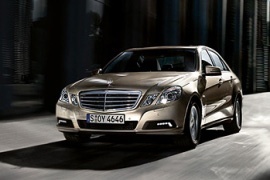
With more than 20 new technical developments, this saloon further consolidates the leading position of Mercedes-Benz in the luxury class.
For more economic efficiency, the E-Klasse is available with a new generation of engines, all of them corresponding to the EU5 standards. For more than 50 years, the saloons in the E-Klasse and their predecessors have been acknowledged as trendsetters in the safety field. The new saloon continues this tradition with an unrivaled combination of the very latest assistance and protection system whose concept and development are based on what actually happens during accidents.

The latest E-Klasse gets yet another upgrade through minor body-shell and interior styling as well as engine replacements.
The formerly used 3.2 L unit gets a displacement boots to 3.5 L, now capable of producing 268 hp while the E 500 remains unchanged. Further additions include a 3.0 L common rail diesel engine for the E320 model while more safety systems become standard. Four-wheel disc brakes and brake assist as well as ESP, ASC (Automatic Slip Control) and active head restraints are among the multitude of passive safety features with the lat one haven’t been available on previous generation models.

The 2011 E-Class was the last to feature round headlights before it switched back to wide, glass-covered, headlamps.
It was one of the most appreciated premium, mid-size sedans, from its times.
With the W211 E-Class, the German car-maker tried to push the boundaries over the limit. It built it very robust and with a wide choice of engines. Its comfort was second only to its bigger brother, the S-Class.
Its predecessor featured four round headlights in the front after it switched from rectangular and horizontal ones. The 2002 E-Class continued the trend and offered the same fascia, but enhanced. Its front panel and grille were raked and showed an enhanced image. Its flowing line over the bodywork showed no concern about not being in the same trend as other car-makers. But it didn’t matter: it was a Mercedes-Benz.
Inside, the wide and comfortable seats in the front were separated by a tall center console. The deep armrest featured a refrigerated compartment. For the comfort of the rear passengers, it was fitted with two air-vents mounted in the back of the center console. The dual-zone climate control was a standard feature. For the audio system, the car offered few choices, including a 10-disc CD-changer in the trunk.
Under the hood, the 2002 E-Class was offered a very wide choice of engines. There were six gasoline, nine diesel, and a CNG version. The latter was specially designed as a fleet car. Standard transmission was a 5- or 6-speed manual, depending on the engine, and a 5-speed automatic gearbox was on the options list.
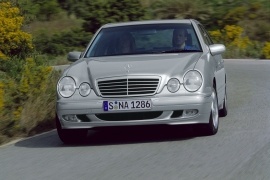
The car was restyled once more in 1999, gaining a newer appearance that was only slightly altered ever since.
The engine range also saw some upgrades while gadgetry was boosted to the next level through the introduction of several top-of-the notch features such as a multi-functional information system integrated into the instrument cluster and a brand new fibre optics entertaining/navcom system. The Steering wheel also received a set of buttons through which all new systems could be easily accessed. Additionally, engines were mated to a 5-speed automatic transmission with manual capability.

The E-Klasse was refreshed in 1995 with the introduction of a visually altered vehicle and different under-hood parts.
The medium-sized sedan received a new front end with quad lights that would later become a class trade mark, as well as a range of new engines. However, the batch of vehicles delivered between 1995 and Y2k is known to have had a series of issues, large enough to spark complaints. Despite the overall renewal of the vehicle, the old 5-cylinder Diesel engine was not updated while the standard Brake Asist system worked improperly. On top of that, multiple rust problems were reported and some were even acknowledged by the producer.

The 500 E from Mercedes-Benz was one of the first attempts to tackle the performance luxury sedans.
It appeared in 1991 and it was developed and built by Porsche in their factory, in Zuffenhausen and it was continued after 1993, in the E 500 facelift.
The short story is that the Mercedes-Benz board had decided to build a performance vehicle out of the well-known W124 E-Class. It took the biggest engine, a 5.0-liter V8, and somehow installed it in the engine bay. But to do this the engine bay had to be enlarged. As a consequence, the front track and the whole car was wider by 56 mm (2.2”) compared to a 300 E. To keep the outside look of the vehicle and cut costs, the car had almost the same body panels except the front where the wheel-arches were flared. On the outside, there were minor changes for the exterior, most noticeable being the clear side indicators instead of the orange ones from the pre-1993 models. A new, plastic bumper, was installed.
Inside, the car had many luxury features such as automatic climate control, an electrically adjustable right side-mirror, dual airbags and an advanced sound system that could be fitted with a CD-changer.
From the technical point of view, the engine was mated to a 4-speed automatic gearbox that had a winter program, when the snow-chains were installed. This program told the car to start directly in the second gear instead of first. The brakes were upgraded to support the heavy vehicle. The 500 E was heavier than a 300 E with 380 kg (837.7 lbs).

The E-Klasse model offered by the German car was launched to the consumer market in the North American market in 1986.
The 300D model offered by Mercedes continued to feature the same economical engine and was often the choice over the 4 and 6 cylinder gasoline engines. The W124 model was introduced with a modified McPherson strut, as well as a Mercedes multi-link axle rear suspension (first seen on the Mercedes 190 in 1982 and which is now set as standard in many Mercedes Benz models). Much of the technology that the E-Klasse brought to the auto market went on being used throughout the industry.

The 1985 face-lift saw the arrival of a heavily changed car sporting new looks and underpinnings.
Fuel efficiency and engine running smoothness were improved through the introduction of modern fuel injection systems that were fitted on all models except the 200 which was equipped with a Stromberg/Pierburg type carburetor. More and more electronics began to find their way into cars and Mercedes-Benz engineers found a clever way to use them through the introduction of an oxygen sensor in the exhaust, mated to a partially electronic fuel injection system that helped both improve fuel consumption and lower emission levels.
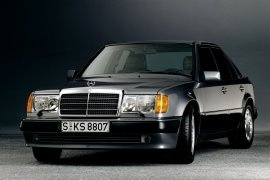
The 500 E from Mercedes-Benz was one of the first attempts to tackle the performance luxury sedan segment.
It appeared in 1991 and it was developed and built by Porsche in its factory, in Zuffenhausen. It was the first 4-door vehicle built in the Porsche factory, long before the Panamera was even on the marketing list.
The short story is that Mercedes-Benz board had decided to built a performance vehicle out of the well-known W124 E-Class. It took the biggest engine, a 5.0-liter V8, and somehow installed it in the engine bay. But to do this the engine bay had to be enlarged. As a consequence, the front track and the whole car was wider by 56 mm (2.2”) compared to a 300 E. To keep the outside look of the vehicle and cut costs, the car had almost the same body panels except from the front, where the wheel-arches were flared.
Inside, the car had many luxury features such as automatic climate control, an electrically adjustable right side-mirror, dual airbags and an advances sound system that could be fitted with a CD-changer.
From the technical point of view, the engine was mated to a 4-speed automatic gearbox that had a winter program, when the snow-chains were installed. This program told the car to start directly in the second gear instead of first. The brakes were upgraded to support the heavy vehicle. The 500 E was heavier than a 300 E by around 380 kg (837.7 lbs).

After the “stroke eight” (W114-W115) model ended its successful career, a new star was born in Stuttgart: the 1975 Mercedes-Benz W123 model, as a model placed under the S-Class range, which was launched in 1972.
The W123 was one of the most reliable cars in the German car manufacturer. Its rattling inline-four diesel engines were built to last forever and some of them were still in use even in 2020 in some countries, used as cabs. The car took some parts from its predecessor such as the semi-trailing rear arm suspension. The model family ranged from the 2.0-liter 4-cylinder Diesel with 55 hp to the 2.8-liter 6-cylinder injection engine with 185 hp.
In the front, the various big round dual headlamps were a characteristic design of the new models. Next to the main headlamp, under a common lens, there was a smaller halogen fog lamp. Differing from that, the two top models of the series, Types 280 and 280 E, were provided with rectangular halogen wide-band headlights. Bigger bumpers were installed for the U.S. market. The straight lines of the vehicle were sweetened by rounded edges. To emphasize the luxury appearance, chromed mirrors and bumpers were installed.
Inside, the car featured cloth seats and four-speed manual transmission on the base trim level. Over time, it received a 5-speed manual and 4-speed automatic transmission. Besides the sedan, coupe, and station-wagon, the car was also available with a long wheelbase, in the form of a limousine, for state-officials or limousine services.

Mercedes-Benz introduced the W123 E-Class in 1973, and four years later, the carmaker introduced a long-wheelbase version, the V123.
The German premium carmaker had a long tradition with its long-wheelbase versions. These vehicles were often used as shuttle cars for hotels, taxi companies, and even diplomatic transportation. Depending on their destination, the carmaker installed more or less features on them.
With a length of 5,355 (17.6’ ft), the V123 was 630 mm (2 ft) longer than the regular W123 sedan. It sported the same front fascia with rectangular horizontal headlights and corner-mounted turn signals. Both versions featured round headlights for specific markets since the squared ones were not legal (in the U.S.). Unlike the American-type limousines, Mercedes-Benz mounted the rear doors on the B-pillar and installed the additional panel behind them, leading to unusually long rear fenders.
Inside, the carmaker offered a choice of interiors and even provided the vehicle with only the bodywork and the front seats, while independent coachbuilders could complete the cabin. While in standard form, the V123 offered room for up to six passengers in the back, three of them being seated facing rearward.
Since it shared its platform with the W123 model, the V123 featured double-wishbone suspension at the front and trailing arms in the rear. That led to a higher comfort level than most other cars on the market. Under the hood, the German carmaker installed a choice of diesel and gasoline engines paired to a four-speed manual or a four-speed automatic. Starting with 1981, the car received a five-speed manual as an option.

Mercedes-Benz introduced the “Stroke-Acht” (slash-eight) W114/115 sedan lineup in 1968 as a successor to the already old W110 model.
The fin-tail Mercedes era was closing to an end, and the German carmaker hired Paul Braq to create a new range of vehicles. He started from a blank sheet of paper and created a minimalist design for a car that became famous and sold in almost two million units globally.
With its vertically mounted, rectangular-shaped with rounded corners headlights, Paul Braq managed to create a legendary look for the car. Everyone could recognize the model even if there was no badge on the hood. Also, the specific Mercedes-Benz design for the grille was unique. The car sported chromed bumpers and exterior trims around the windows and on the side panels. In the back, the flat trunk lid was slightly sloped. Underneath it, the horizontal taillights featured reversing lights on both sides. An extended wheelbase version was available as well.
Depending on the trim level and option, the W114/115 featured cloth or leather seats. The carmaker installed two large dials for the speedometer and tachometer on the dashboard, while other gauges showed the fuel level, coolant temperature, oil pressure, and the ammeter. A safety cell surrounded the cabin, protecting the occupants. For the extended wheelbase version, the carmaker installed three seat rows and room for up to eight occupants.
The W114/115 featured a completely new platform with semi-trailing arms in the rear to increase comfort and road-holding. The carmaker installed a wide engine choice for those years, including diesel and gasoline engines.

Heralding the inception of the successful “Fintail” dynasty, the W110 appeared as a little gorgeous four seater in the 1960’s.
Introduced with a choice of one petrol unit and a Diesel plant, both displacing 1.9 L, the cars were built to compete on the North American market with the car having been designed with an American style-inspired rear adorned with two small “fins” placed above the tail lights. Th line-up remained unchanged until 1965 when it saw a refresh and introduction of two new engines with capacities of 2.0 L and 2.3 L. Most importantly, the small-Fintail was the first car that went through extensive crash-testing.
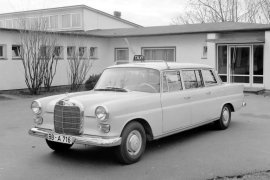
Mercedes-Benz introduced a seven-seat, long-wheelbase option for the E-Class, designed either for taxi drivers or for executive orders.
The German carmaker introduced the 190 model in 1961 with a new design detail that brought it the fintail-body nickname. It replaced the “ponton” range with larger, more commanding-looking vehicles. Mercedes-Benz built the 190 based on the 220b model, with the same front and rear axles carried over. The solution led to lower development costs and helped the carmaker on the market.
At the front, it kept the same front fascia with a narrow and tall grille, mounted straight-up in front of the hood. In front of it, on the lower side, the carmaker installed a chromed metallic bumper wrapped around the front corners. Up to the B-pillars and from the rear windscreen, it used the same parts as the regular version. The rear doors didn’t have a cut for the rear wheels and, behind them, the carmaker added a longer quarter panel and an additional window for the last row of seat passengers. In the back, the narrow and tall fenders formed a tail, from which the car received its nickname.
Inside, the sloped and narrow dashboard featured a taller area for the instrument cluster. The carmaker installed either vertical dials with sliders or round dials for the speedometer and the oil pressure, coolant temperature, and fuel level gauges. Between them, on the upper side, Mercedes-Benz installed a clock. The carmaker placed a tilt and tumble seat for the middle row, which allowed the ingress and egress for the rear passengers.
Under the hood, Mercedes-Benz installed a 1.9-liter, inline-four engine for the base model. Later on, the carmaker added an inline-six and a four-pot diesel.

The Type 180 was nicknamed “Ponton” due to its entirely new concept.
Unlike its predecessors, it featured a ponton body, which meant that the fenders were integrated into the bodywork.
The automotive design was changing and Mercedes-Benz had to keep-up with it. The times of the long and arched fenders were gone. The times of exposed spare-wheels and headlights on a chromed rod were also a feature of the past. And then, the Mercedes-Benz “Ponton” was born.
It was introduced in August 1953 and the entire construction was meant to be more aerodynamic and more rigid than the previously Typ 170. It featured higher fenders and integrated headlamps. The rounded greenhouse and the three-box shape was different than its predecessor, but still had some design clues from the past at the front of the car, where the chromed tall and narrow grille was present.
Inside, the car featured more room for the head due to the higher roof. A bench in the front was offered, but most of the cars featured two seats in the front and a bench in the back. There was no folding seatback. The trunk, with its curved and sloped lid, accommodated the spare-wheel.
Under the hood, the Typ 180 was offered with a choice of diesel and gasoline engines. There were only four-cylinder units available with a power range between 43 hp and 80 hp. In 1955, the car received a new rear axle, which made the car more comfortable and better planted to the road.

The W136 platform became the womb for post-war models, having been the single one that survived Allied bombings.
The 170 had a look close to that of mob-car although its purpose was primarily that of delivering a safe and quality ride to buyers and not that of providing a fast-rolling post with guns attached. Fitted with a 38 hp 1.7 L petrol unit, the 170 model reached a top speed of 67 mph (108 kmh) while its 100 Nm of max torque translated as great pulling power. Even more, performance came in fuel efficient package, with the car having had an average of 23.5 mpg.

After the war, all of Europe was destroyed and Germany didn’t have an industry anymore.
Mercedes-Benz gathered its forces and brought back its engineers to the drawing board. They had a country to revive and a company to grow.
The design team didn’t start from a blank sheet of paper. They had some of the plans used before and during WWII. In 1946 they started with a delivery van built on that chassis. There was a high demand for vans to be used or converted into ambulances and police cars. In 1949, Mercedes-Benz introduced the 170 S series at the technical export fair in Hanover. It was its first, post-war, top-class passenger vehicle, based on the same W136 chassis.
The new 170 S was based on some pre-war models, especially on the W153 model. The convertible was available as a two- or a four-seat vehicle named Cabriolet A, and Cabriolet B, respectively. The former was considered a luxury car. The flared arches, the narrow and tall engine compartment was a relic from the past but helped the German brand to move on.
Inside, the Cabriolet A featured a shelf behind the seats. It was used as an extra luggage compartment. Some were fitted with seats fit for children. The dash panel featured a radio in the middle and a glove-compartment on the passenger side. For the instrument cluster, there was a big clock on the left and a speedometer on the right, in front of the driver. In the middle, the car-maker installed the fuel-level gauge and the volt-meter. The floor-mounted gear-stick featured a round, white, gear-knob.
For the engine compartment, the 170S Cabriolet was fitted with a 1.8-liter gasoline engine. Unlike its panel-van siblings, it wasn’t fitted with a diesel unit. The four-speed manual gearbox was the only choice.























































